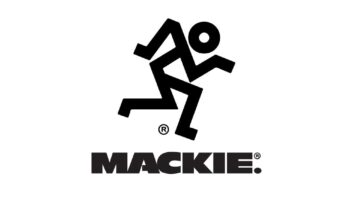The Mackie SRM450 powered PA loudspeakers are welcome companions for live remote broadcasts. Being amplified cabinets, they are not exactly light, but they are manageable due to careful design and layout.
The sound quality of the SRM450 is excellent right up to high volume levels. These are loud and clean and do an excellent job filling all but the largest auditoriums with the sound of a station.
Product CapsuleThumbs Up
Excellent handle layout
Great sound
Rugged
Thumbs down
Heavy
Limited LF response
Price: $899
For more information contact Mackie Design in Washington state at (800) 258-6883 or visit www.mackie.com.
The SRM450s are a midsized package (26 by 15.4 by 14.8 inches) that weigh in at 51 pounds. The molded plastic enclosure has integrated handles on both sides as well as one on the top.
A variety of positions are possible. The base has three rubber feet for standing on the floor as well as an insert for pole mounting. There are numerous fly points to suspend it securely. Its asymmetrical trapezoidal shape makes it work well as a floor monitor when set on its side.
The 12-inch woofer is protected by a steel mesh front panel. The tweeter is recessed deep in the case with the enclosure serving as a horn. The high-impact materials and the solid design make for a rugged package.
Although I did not subject them to the “bounce” test, they appear to be ready to absorb most anything short of deliberate abuse. Diminutive staff members may have a hard time hefting these onto poles, but ours had no difficulty. The placement and size of the handles certainly helps.
The rear control panel includes peak-level and thermal warning LEDs, a master-level control, a low-cut filter as well as a sound contour switch.
The I/O is a standard XLR female alongside an XLR male, wired in parallel so that additional speakers can be daisy-chained to a single source. There is no need to bring the manual along to figure this out. A little experimentation shows what the options offer.
Inside, the biamplified design has a 300 W RMS low-frequency amp and a 100 W RMS amp for the high frequencies.
The woofer is rated to handle 450 W, so there is plenty of headroom to spare. A good-sized die-cast aluminum heatsink on the back helps both amplifier circuits run at high power for extended periods.
Both are protected by a thermal switch, which kicks in if they overheat. A timed turnoff feature puts the speaker into sleep mode following three minutes of silence.
Test runs
I tested a pair of SRM450s in a variety of settings. I ran the first test in my home studio just to get some sense of the sound quality. I connected the loudspeakers to a Mackie 1202 board and played material through a Digital Audio Labs CardDeluxe in my production computer.
Listening to a variety of music and assorted production work, the clarity and three-dimensionality was impressive. The mid- to upper-frequency response was superb. Bass did become muddy in the lowest octave.
If you want to get a cleaner thump, Mackie recommends adding the SWA1501 powered sub. That will load an additional 500-plus watts of bass into the mix. Aside from that, the home studio test showed that these sounded better than I expected. They are good enough that those on a budget might consider these for use as a studio monitor as well as a PA. Note that they are not magnetically shielded, so using them as nearfields next to a computer monitor would be problematic.
Other test settings included use as a stage monitor for a local country and western band called “Maine Squeeze” and at a business fair for WTSN(AM) and WBYY(FM) in Rochester, N.H.
On stage, the SRM450s demonstrated an impressive resistance to feedback. If a deliberate effort is made, you will get feedback, but accidental feedback seemed greatly reduced.
In its literature, Mackie attributes this to the sonic purity of the drivers. What matters is that feedback issues are minimal. That can save a lot of trouble during live remote broadcasts.
The outing with WTSN and WBYY was a typical “meet and greet” fair with local businesses. The SRM450s were playing the WBYY signal from a boombox.
In this setting, the speakers had more than enough response to reproduce the frequency range of the broadcast signal. Setup was simple and fast. After hoisting the units on poles, they were easy to secure with the turnscrews incorporated into the base of the SRM450.
Volume levels were not pushed, in fairness to other exhibitors. At the max, these can generate SPLs reaching 120 dB up close – not good for business or your hearing! Basically, these were overkill for this app, but the handy design meant that they were not a burden to bring. After the fair, the Mackies were easy to toss into the shipping boxes and fit nicely into the backseat of my midsized coupe.
Mackie SRM450s are solidly built and carefully thought-through for the rigors of the road. Their musicality is limited only on the LF response and by the acoustic characteristics of where they are set up.











